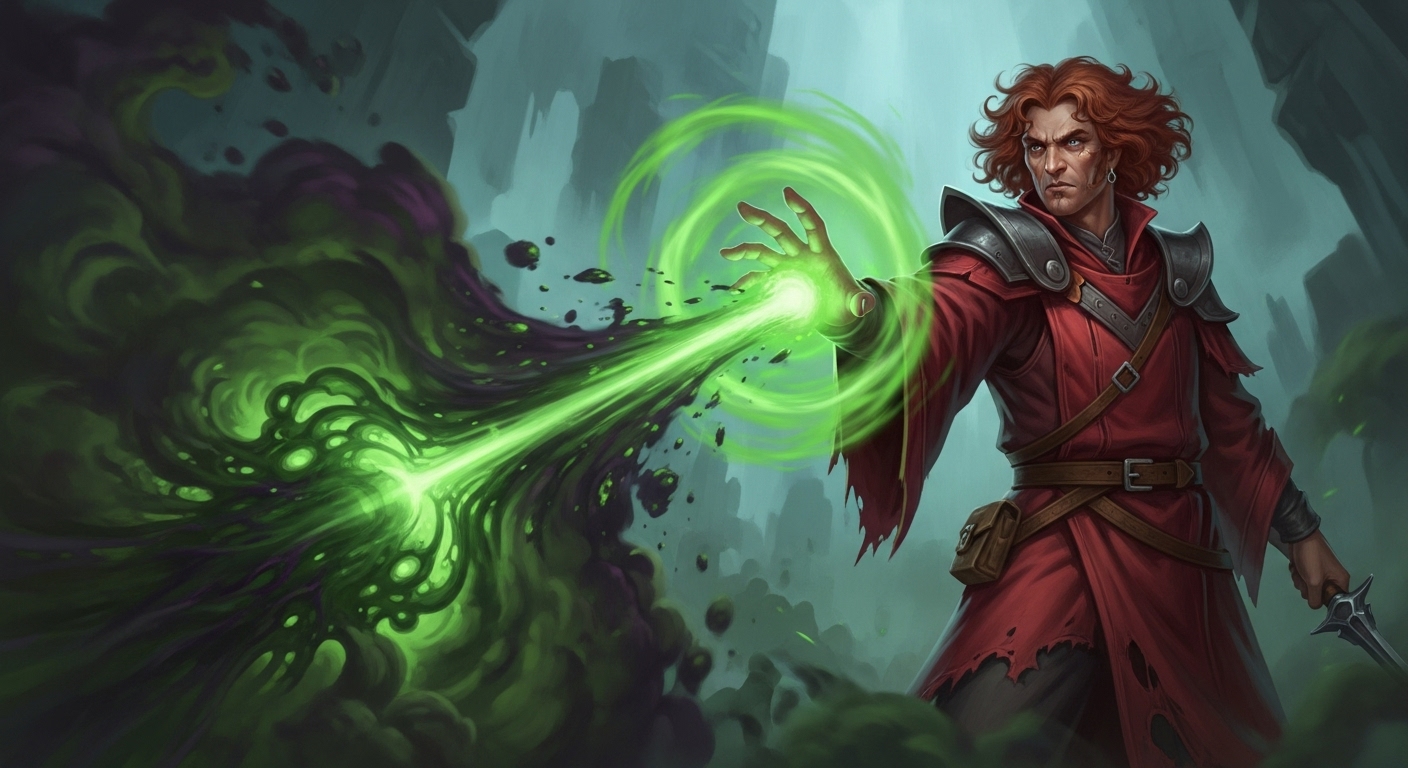Poison Spray

- Level: Cantrip
- School: Necromancy
- Class: Druid, Sorcerer, Warlock, Wizard
- Casting Time: Action
- Range: 30 feet
- Components: V, S
- Duration: Instantaneous
You spray toxic mist at a creature within range. Make a ranged spell attack against the target. On a hit, the target takes 1d12 Poison damage.
Cantrip Upgrade. The damage increases by 1d12 when you reach levels 5 (2d12), 11 (3d12), and 17 (4d12).
Tactical Usage
High-Damage Cantrip Option. Poison Spray offers excellent damage potential for a cantrip with 1d12 base damage that scales to 4d12 at high levels, making it competitive with weapon attacks throughout character progression.
Range Advantage. The 30-foot range provides safe spellcasting distance while remaining close enough for accurate targeting, positioning casters beyond most melee threats while maintaining offensive capability.
Constitution Targeting. Unlike many attack-based cantrips, Poison Spray targets Constitution saves, which tend to be lower on spellcasters and certain creature types compared to AC values.
Spell Combinations
Debuff Synergy. Combining with effects that impose disadvantage on Constitution saves, such as certain poisons or magical debuffs, significantly improves the spell's hit rate and damage consistency.
Positioning Enhancement. Movement spells like Misty Step or defensive options like Shield help maintain optimal range for repeated Poison Spray usage while avoiding enemy retaliation.
Area Control Support. Using Poison Spray while enemies are constrained by Web, Entangle, or difficult terrain prevents them from closing distance and forces them to endure repeated cantrip attacks.
Material Component Details
Component-Free Advantage. Poison Spray requires no material components, making it reliable in situations where equipment is restricted, lost, or unavailable due to imprisonment or environmental hazards.
Gesture Requirements. Somatic components require one free hand for spellcasting, which might conflict with weapon and shield usage but remains manageable for most caster builds.
Verbal Components. The spell requires spoken incantations that prevent use during stealth situations or in areas where silence is required for tactical reasons.
Creator Notes
Poison Resistance Consideration. Many creatures, particularly undead, constructs, and certain planar beings, have poison resistance or immunity, potentially reducing this cantrip's effectiveness compared to more universal damage types.
Scaling Balance. The high damage potential balances against Constitution save targeting rather than attack rolls, creating different tactical considerations for players and encounter design.
Environmental Storytelling. Poison Spray creates visible toxic effects that can leave environmental traces, affect plant life, or create atmospheric details that enhance dungeon or combat encounters.
Environmental Interactions
Toxic Atmosphere Creation. Repeated use of Poison Spray might create lingering toxic effects in enclosed spaces, though the spell itself has instantaneous duration without ongoing environmental impact.
Plant and Wildlife Effects. The toxic mist might affect nearby vegetation or small creatures, creating environmental storytelling opportunities without mechanical benefits.
Wind and Weather. Strong winds or environmental conditions might affect the visual description of the toxic spray without mechanically impacting the spell's targeting or effectiveness.
Common Rulings & Clarifications
Constitution Save Mechanics. Targets roll Constitution saving throws against the caster's spell save DC, with failure resulting in full damage and success negating all damage effects.
Damage Type Consistency. The spell deals poison damage exclusively, making it subject to poison resistance, immunity, and vulnerability effects that modify the final damage total.
Range and Targeting. Standard ranged spell attack rules apply, requiring line of sight and clear path to the target within the 30-foot range limitation.
Scaling Progression. Damage increases occur at specific character levels (5th, 11th, 17th) regardless of class progression, affecting multiclass characters based on total character level.
Alternative Applications
Non-Combat Utility. Poison Spray might serve as a tool for creating toxic substances for crafting, research, or environmental manipulation outside of direct combat applications.
Intimidation Support. The visible toxic effects and necromantic nature can enhance intimidation attempts or create psychological pressure during social encounters.
Environmental Manipulation. Destroying small plants, clearing insect swarms, or creating visible signs of magical activity for communication or marking purposes.
Related Spells
Damage Cantrip Comparison. Fire Bolt offers higher damage consistency with attack rolls, while Acid Splash provides area damage, and Sacred Flame targets Dexterity saves with radiant damage.
Poison Magic Progression. Poison Spray leads to higher-level poison effects like Poison Cloud, Cloudkill, or other necromantic damage spells that share thematic elements.
Constitution-Targeting Magic. Spells that target Constitution saves, such as certain disease or exhaustion effects, share tactical synergy with Poison Spray's save-based mechanics.
Scaling Analysis
Excellent Late-Game Potential. The 4d12 damage at high levels makes Poison Spray one of the strongest cantrips available, competing effectively with weapon attacks and providing sustainable damage output.
Campaign Utility Variation. Effectiveness varies significantly based on campaign creature types - poison-heavy environments reduce utility while campaigns featuring living humanoids maintain high effectiveness.
Resource Independence. As a cantrip, Poison Spray provides unlimited usage that becomes increasingly valuable as higher-level spell slots are reserved for more specialized applications.
Narrative Flavor
Toxic Manifestation. The spell should emphasize the necromantic nature of the magic, creating genuinely harmful toxic substances rather than simple illusory effects or harmless magical energy.
Visual Description Variety. Different casters might manifest poison spray as noxious gas clouds, acidic droplets, diseased spores, or other toxic substances reflecting their magical tradition and personality.
Environmental Impact. The toxic spray should appear genuinely dangerous, with effects like corroding surfaces, withering plants, or creating visible contamination that reinforces the spell's necromantic school and poison damage type.